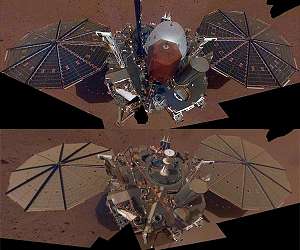Seismic data collected in Elysium Planitia, the second largest volcanic region on Mars, suggest the presence of a shallow sedimentary layer sandwiched between lava flows beneath the planet’s surface. These findings were gained in the framework of NASA’s InSight mission, in which several international research partners, including the University of Cologne, collaborate. The paper ‘The shallow structure of Mars at the InSight landing site from inversion of ambient vibrations’ will appeared in Nature Communications on 23 November.
Geophysicist Dr Cedric Schmelzbach from ETH Zurich and colleagues, including the earthquake specialists Dr Brigitte Knapmeyer-Endrun and doctoral researcher Sebastian Carrasco (MSc) from the University of Cologne’s Seismic Observatory in Bensberg, used seismic data to analyse the composition of the Elysium Planitia region.
The authors examined the shallow subsurface to around 200 metres in depth. Right beneath the surface, they discovered a regolith layer of dominantly sandy material approximately three metres thick above a 15 metre layer of coarse blocky ejecta – rocky blocks that were ejected after a meteorite impact and fell back to the surface.
Below these top layers, they identified around 150 metres of basaltic rocks, i.e., cooled and solidified lava flows, which was largely consistent with the expected subsurface structure. However, between these lava flows, starting at a depth of about 30 metres, the authors identified an additional layer 30 to 40 metres thick with low seismic velocity, suggesting it contains weak sedimentary materials relative to the stronger basalt layers.
To date the shallower lava flows, the authors used crater counts from existing literature. Established knowledge about the impact rate of meteorites allows geologists to date rocks: surfaces with many impact craters from meteorites are older than ones with fewer craters. Also, craters with larger diameters extend into the lower layer, allowing the scientists to date the deep rock, while smaller ones allow them to date the shallower rock layers.
They found that the shallower lava flows are approximately 1.7 billion years old, forming during the Amazonian period – a geological era on Mars characterized by low rates of meteorite and asteroid impacts and by cold, hyper-arid conditions, which began approximately 3 billion years ago. In contrast, the deeper basalt layer below the sediments formed much earlier, approximately 3.6 billion years ago during the Hesperian period, which was characterized by widespread volcanic activity.
The authors propose that the intermediate layer with low volcanic velocities could be composed of sedimentary deposits sandwiched between the Hesperian and Amazonian basalts, or within the Amazonian basalts themselves. These results provide the first opportunity to compare seismic ground-truth measurements of the shallow subsurface to prior predictions based on orbital geological mapping.
Prior to the landing, Dr Knapmeyer-Endrun had already developed models of the velocity structure of the shallow subsurface at the InSight landing site based on terrestrial analogues. The actual measurements now indicate additional layering as well as more porous rocks in general.
‘While the results help to better understand the geological processes in Elysium Planitia, comparison with pre-landing models is also valuable for future landed missions, since it can help to refine predictions,’ Knapmeyer-Endrun remarked. Knowledge of the properties of the shallow subsurface is required to assess, for example, its load-bearing capacity and trafficability for rovers.
Besides, details on the layering in the shallow subsurface help to understand where it might still contain ground water or ice. Within the framework of his doctoral research at the University of Cologne, Sebastian Carrasco will continue to analyse the effect of the shallow structure of Elysium Planitia on marsquake recordings.
The InSight lander arrived on Mars on 26 November 2018, touching down in the Elysium Planitia region. Mars has been the target of numerous planetary science missions, but the InSight mission is the first to specifically measure the subsurface using seismic methods.
Related Links
University of Cologne
Mars News and Information at MarsDaily.com
Lunar Dreams and more
|
We need your help. The SpaceDaily news network continues to grow but revenues have never been harder to maintain. With the rise of Ad Blockers, and Facebook – our traditional revenue sources via quality network advertising continues to decline. And unlike so many other news sites, we don’t have a paywall – with those annoying usernames and passwords. Our news coverage takes time and effort to publish 365 days a year. If you find our news sites informative and useful then please consider becoming a regular supporter or for now make a one off contribution. |
||
|
SpaceDaily Contributor $5 Billed Once credit card or paypal |
SpaceDaily Monthly Supporter $5 Billed Monthly paypal only |
|

![]()
NASA’s InSight finds three big marsquakes, thanks to solar-panel dusting
Pasadena CA (JPL) Sep 24, 2021
The lander cleared enough dust from one solar panel to keep its seismometer on through the summer, allowing scientists to study the three biggest quakes they’ve seen on Mars.
On Sept. 18, NASA’s InSight lander celebrated its 1,000th Martian day, or sol, by measuring one of the biggest, longest-lasting marsquakes the mission has ever detected. The temblor is estimated to be about a magnitude 4.2 and shook for nearly an hour-and-a-half.
This is the third major quake InSight has detected in a m … read more